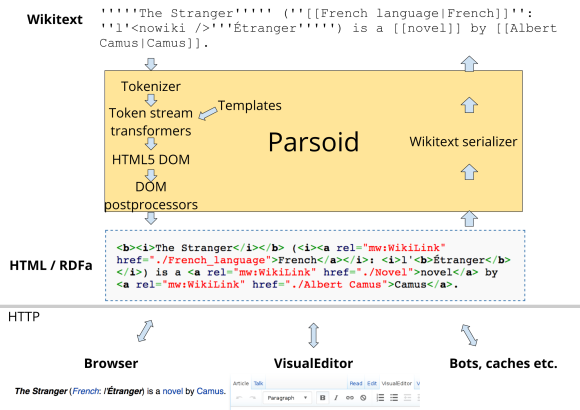
We at the Wikimedia Foundation, in conjunction with Wikia, are building the VisualEditor for Wikipedia and all other sites based on the MediaWiki software. This is taking us some time, and we often get asked what’s involved in this, just how hard it is, and why it’s taking us so long, so we thought we’d explain some of the intricacies in the most challenging software project the Wikimedia Foundation has ever worked on.
What are we trying to do?
We are creating software that will let users load, edit and save Wikipedia articles visually, bypassing the existing system that requires our users learn “wikitext,” a complex markup code. Instead, the articles they’re editing will look the same as when they’re reading them, and any changes they make will be obvious in their effects before they press save — just like writing a document in a word processor.
Haven’t people done this before?
Yes and no. There are lots of visual text editors out there, and even a few open source ones that can edit Web pages quite well, but they are insufficient for our needs for a number of reasons.
One criterion that is hugely important to us is that our editor should work with lots of languages. This is not just a matter of supporting certain right-to-left languages, or a few based on ideograms, but being able to use any and all of the 290 languages we currently provide. We also want to be able to do so seamlessly in the same documents to support our multi-lingual communities. Some of the languages we are committed to working with have very little software support, and we are often one of the few sources of written material for them, or at least, one of the largest.
Another issue is that wikitext has grown over the past 12 years to have a large number of rich and complicated features that are not just “simplified ways of writing HTML.” Though we originally intended many of these to be used only occasionally, they have often evolved to be at the core of how MediaWiki pages are now written by many Wikimedia users and more widely.
These advanced features include content transclusion (pulling in a “live” copy of one page or part of it into another), templates (transclusion with parts defined at the second page rather than the source), and parser functions (pages that show different things depending on hundreds of potential options, like the day of the week or whether another page exists). Attempting to retrofit this into an existing editor would have been exceptionally difficult, and more work than starting from scratch.

What is the parser?
Finally, we need to not just edit pages, but to read and save existing wiki pages in the old wikitext format, and continue to work with it in parallel to the new editor. We can’t throw away the huge amount of work our communities have done over the past 12 years, so we need to re-write the “translator.” This means making a two-way “parser” — a bit of software that converts wikitext into HTML and back again. Until now, we have only had a one-way parser; the second stage, converting back from what people want to write to wikitext, has had to be done by our editors in their heads.
This means that we’ve had to have an entirely separate project – the Parsoid – that can translate in both directions: from wikitext to Web pages and also back again. This is not remotely an easy task; you have to be very attentive in replacing a parser, as it’s hugely important that we don’t break anything. The old parser, and the wikitext “language” it interprets, just grew organically as people had ideas, and no one really designed it. There are nearly two billion versions of pages in Wikimedia’s wikis alone, and this lack of design means that there are a huge number of little rules we need Parsoid to follow to avoid “dirty-diffs” — issues where the wikitext would be broken by people using the VisualEditor.

We use automated testing to “round-trip” 100,000 randomly chosen pages from the English Wikipedia (as a reasonable sample of wiki content in the Latin alphabet): taking the wikitext, converting it to HTML format and back to wikitext, and comparing the result. This helps us by identifying many issues to fix so that using Parsoid does not cause articles to break. Right now we get about 80 percent of these articles to round-trip without any differences at all (up from 65 percent in October), an additional 18 percent round-trip with only minor differences (whitespace, quote style etc.), and the remaining 2 percent of pages have differences that still need fixing (down from about 15 percent in October).
Learn more
As you can see, to make a visual editor that our users need is a large amount of work. No existing technologies could do what we wanted to, so we have needed to work very hard to make sure that we deliver this. We look forward over the next few months to showing off how editors will be able to use VisualEditor and Parsoid for a much better experience, free of learning any complicated codes, letting them focus on the content and not the tool they use to write it.
If you’re interested, we have a brief presentation about how Parsoid and VisualEditor work, and what they will look like on Wikipedia.
James Forrester, Product Manager, VisualEditor and Parsoid

Can you help us translate this article?
In order for this article to reach as many people as possible we would like your help. Can you translate this article to get the message out?
Start translation